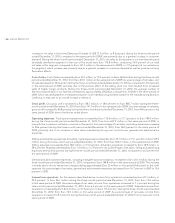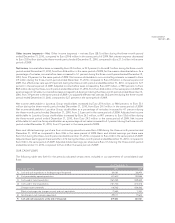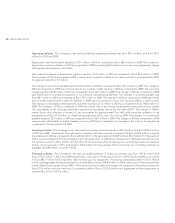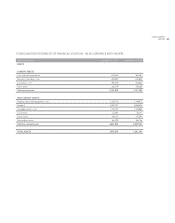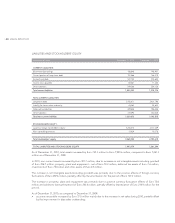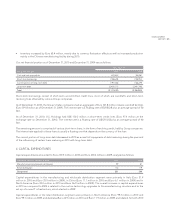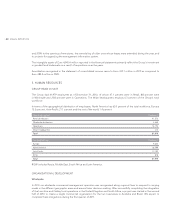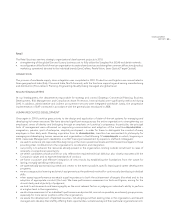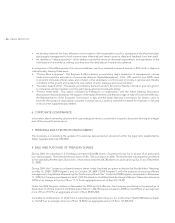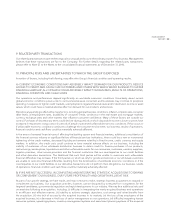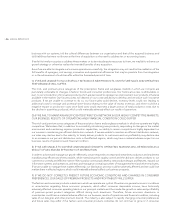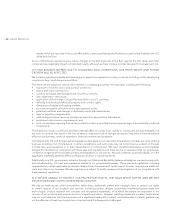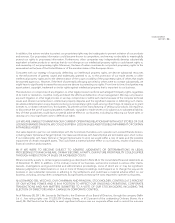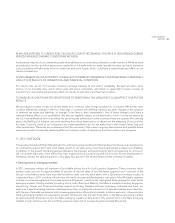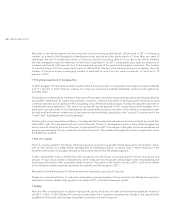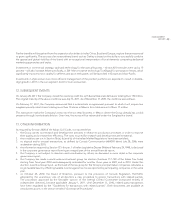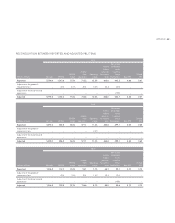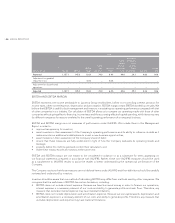LensCrafters 2010 Annual Report Download - page 58
Download and view the complete annual report
Please find page 58 of the 2010 LensCrafters annual report below. You can navigate through the pages in the report by either clicking on the pages listed below, or by using the keyword search tool below to find specific information within the annual report.ANNUAL REPORT 2010> 56 |
business with our systems; (vii) the cultural differences between our organization and that of the acquired business; and
(viii) liabilities that were not known at the time of acquisition or the need to address tax or accounting issues.
If we fail to timely recognize or address these matters or to devote adequate resources to them, we may fail to achieve our
growth strategy or otherwise realize the intended benefits of any acquisition.
Even if we are able to integrate our business operations successfully, the integration may not result in the realization of the
full benefits of synergies, cost savings, innovation and operational efficiencies that may be possible from the integration
or in the achievement of such benefits within the forecasted period of time.
C) IF WE ARE UNABLE TO SUCCESSFULLY INTRODUCE NEW PRODUCTS, OUR FUTURE SALES AND OPERATING
PERFORMANCE WILL SUFFER
The mid– and premium–price categories of the prescription frame and sunglasses markets in which we compete are
particularly vulnerable to changes in fashion trends and consumer preferences. Our historical success is attributable, in
part, to our introduction of innovative products which are perceived to represent an improvement over products otherwise
available in the market. Our future success will depend on our continued ability to develop and introduce such innovative
products. If we are unable to continue to do so, our future sales could decline, inventory levels could rise, leading to
additional costs for storage and potential write–downs relating to the value of excess inventory, and there could be a
negative impact on production costs since fixed costs would represent a larger portion of total production costs due to
the decline in quantities produced, which could materially adversely affect our results of operations.
D) IF WE FAIL TO MAINTAIN AN EFFICIENT DISTRIBUTION NETWORK IN OUR HIGHLY COMPETITIVE MARKETS,
OUR BUSINESS, RESULTS OF OPERATIONS AND FINANCIAL CONDITION COULD SUFFER
The mid– and premium–price categories of the prescription frame and sunglasses markets in which we operate are highly
competitive. We believe that, in addition to successfully introducing new products, responding to changes in the market
environment and maintaining superior production capabilities, our ability to remain competitive is highly dependent on
our success in maintaining an efficient distribution network. If we are unable to maintain an efficient distribution network,
our sales may decline due to the inability to timely deliver products to customers and our profitability may decline due
to an increase in our per unit distribution costs in the affected regions, which may have a material adverse impact on our
business, results of operations and financial condition.
E) IF WE ARE UNABLE TO ACHIEVE AND MANAGE GROWTH, OPERATING MARGINS WILL BE REDUCED AS A
RESULT OF DECREASED EFFICIENCY OF DISTRIBUTION
In order to achieve and manage our growth effectively, we are required to increase and streamline production and implement
manufacturing efficiencies where possible, while maintaining strict quality control and the ability to deliver products to our
customers in a timely and efficient manner. We must also continuously develop new product designs and features, expand our
information systems and operations, and train and manage an increasing number of management level and other employees.
If we are unable to manage these matters effectively, our distribution process could be adversely affected and we could lose
market share in affected regions, which could materially adversely affect our business prospects.
F) IF WE DO NOT CORRECTLY PREDICT FUTURE ECONOMIC CONDITIONS AND CHANGES IN CONSUMER
PREFERENCES, OUR SALES OF PREMIUM PRODUCTS AND PROFITABILITY WILL SUFFER
The fashion and consumer products industries in which we operate are cyclical. Downturns in general economic conditions
or uncertainties regarding future economic prospects, which affect consumer disposable income, have historically
adversely affected consumer spending habits in our principal markets and thus made the growth in sales and profitability
of premium–priced product categories difficult during such downturns. Therefore, future economic downturns or
uncertainties could have a material adverse effect on our business, results of operations and financial condition, including
sales of our designer and other premium brands. The industry is also subject to rapidly changing consumer preferences
and future sales may suffer if the fashion and consumer products industries do not continue to grow or if consumer


